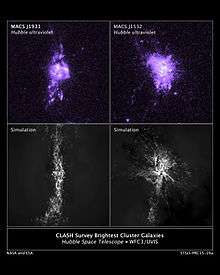Cluster Lensing and Supernova survey with Hubble

The Cluster Lensing And Supernova survey with Hubble (CLASH) is a multi-wavelength census of 25 massive galaxy clusters with Advanced Camera for Surveys (ACS) and Wide Field Camera 3 (WFC3) instruments of Hubble Space Telescope over a 3.5 year period (2010 - 2013).
The gravity of these massive clusters is powerful enough to visibly bend the path of light, somewhat like a magnifying glass and are thus useful tools for studying very distant objects. They also contribute to a range of topics in cosmology, as the precise nature of the lensed images encapsulates information about the properties of spacetime and the expansion of the cosmos.
History

As of November 2012, the CLASH has surveyed 20 clusters out of the 25. One of the galaxy clusters, MACS J0647+7015 was found to have gravitationally lensed the most distant galaxy (MACS0647-JD) then ever imaged, in 2012.[2][3]
In 2013, one study utilizing CLASH data found that RX J1347.5-1145 had intense gravitational bending of light such that 8 images of the same object were detected.[4] (See Gravitational lensing)
The Principal Investigator of the CLASH program is Marc Postman.
Clusters under observation
List of clusters is:[5]
| Galaxy cluster | Right Ascension | Declination | Redshift | Notes |
|---|---|---|---|---|
| Abell 209 (ACO 209) | 01:31:52.57 | -13:36:38.8 | 0.206 | |
| Abell 383 (ACO 383) | 02:48:03.36 | -03:31:44.7 | 0.187 | |
| MACS0329.7-0211 | 03:29:41.68 | -02:11:47.7 | 0.450 | |
| MACS0429.6-0253 | 04:29:36.10 | -02:53:08.0 | 0.399 | |
| MACS0744.9+3927 | 07:44:52.80 | +39:27:24.4 | 0.686 | |
| Abell 611 (ACO 611) | 08:00:56.83 | +36:03:24.1 | 0.288 | |
| MACS1115.9+0129 | 11:15:52.05 | +01:29:56.6 | 0.352 | |
| Abell 1423 (ACO 1423) | 11:57:17.26 | +33:36:37.4 | 0.213 | |
| MACS1206.2-0847 | 12:06:12.28 | -08:48:02.4 | 0.890 | |
| CLJ1226.9+3332 (ClG J1226.9+3332) | 12:26:58.37 | +33:32:47.4 | 0.890 | |
| MACS1311.0-0310 | 13:11:01.67 | -03:10:39.5 | 0.494 | |
| RX J1347.5-1145 | 13:47:30.59 | -11:45:10.1 | 0.451 | [Notes 1] |
| MACS1423.8+2404 | 14:23:47.76 | +24:04:40.5 | 0.545 | |
| RXJ1532.9+3021 | 15:32:53.78 | +30:20:58.7 | 0.345 | |
| MACS1720.3+3536 | 17:20:16.95 | +35:36:23.6 | 0.391 | |
| Abell 2261 (ACO 2261) | 17:22:27.25 | +32:07:58.6 | 0.224 | |
| MACS1931.8-2635 | 19:31:49.66 | -26:34:34.0 | 0.352 | |
| RXJ2129.7+0005 | 21:29:39.94 | +00:05:18.8 | 0.234 | |
| MS2137-2353 | 21:40:15.18 | -23:39:40.7 | 0.313 | |
| RXJ2248.7-4431 (Abell 1063S / ACO 1063S) | 22:48:44.29 | -44:31:48.4 | 0.348 | |
| MACS0416.1-2403 | 04:16:09.39 | -24:04:03.9 | 0.42 | |
| MACS0647.8+7015 | 06:47:50.03 | +70:14:49.7 | 0.584 | |
| MACS0717.5+3745 | 07:17:31.65 | +37:45:18.5 | 0.548 | |
| MACS1149.6+2223 | 11:49:35.86 | +22:23:55.0 | 0.544 | |
| MACS2129.4-0741 | 21:29:26.06 | -07:41:28.8 | 0.570 | |
Notes
- ↑ One of the most X-ray luminous and most massive cluster known, with an X-ray luminosity in excess of 10^45^erg/s. Magellan Spectroscopy of the Galaxy Cluster RX J1347.5-1145: Redshift Estimates for the Gravitationally Lensed Arcs
References
- ↑ "CLASH Survey Brightest Cluster Galaxies and Simulations". Retrieved 10 August 2015.
- ↑ Hubble helps find candidate for most distant object in the Universe yet observed
- ↑ Scientific Objectives of CLASH
- ↑ F. Köhlinger and R.W. Schmidt - Strong lensing in RX J1347.5-1145 revisited (2013)
- ↑ THE CLUSTER LENSING AND SUPERNOVA SURVEY WITH HUBBLE: AN OVERVIEW